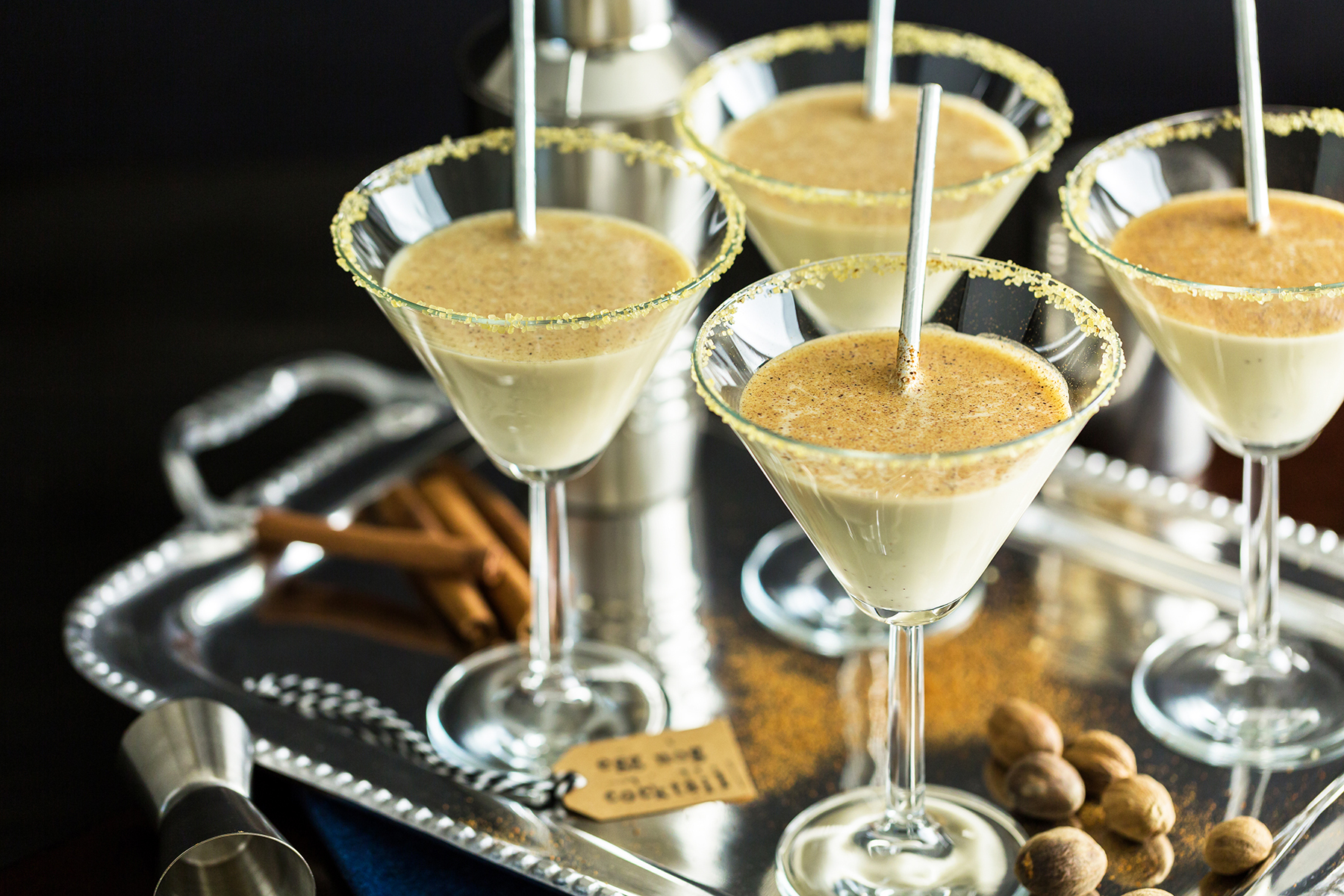Fallin' For Eggnog

You know the holiday season is officially here when the cinnamon and pumpkin spiced drinks start to flow, but if ever there was one beverage that has been – and continues to be – synonymous with the holidays, it’s eggnog. This rich, creamy concoction, with its dashes of nutmeg and cinnamon and a splash of spirits, has long been a hallmark of winter celebrations. Eggnog’s blend of eggs, milk, sugar, and spices creates a symphony of flavors that embody the joy of the holidays.
Our eggnog journey began during the 13th century, when medieval monks in Britain en-joyed “posset,” a warm ale punch with eggs and figs, often touted for its supposed medicinal properties. It was a drink of the wealthy, as milk, eggs, and spirits were luxuries not readily available to the common folk. By the 17th century, sherry became the key ingredient, and this eggy beverage was regularly used to toast to health and prosperity.
Eggnog became tied to the holidays and took on a whole new taste when it hopped the pond in the 1700s. While brandy and sherry were the spirits of choice in Europe, they were heavily taxed in America. Rum, on the other hand, was easily accessible due to the thriving trade with the Caribbean, becoming the perfect substitution and the basis for the cocktail that we know and love today. In the South, people tended to prefer whiskey over rum. In the 1887 printing of The Bar-tender’s Guide, it was noted that “hot egg nogg” was “very popular in California,” while the others were served over ice or cooled in an ice tub. Across the U.S. and beyond, variations of eggnog abound. Coquito is the tradition in Puerto Rico, Rompopo in Central America, Biersuppe in Germany, and Advocaat in the Netherlands and Belgium. These variations reflect how each culture incorporates its unique ingredients and culinary traditions into the drink. Despite these differences, eggnog’s essence as a beverage of celebration and togetherness remains constant, uniting people across the globe in the spirit of the holiday season.
Folklore suggests that George Washington devised his own eggnog recipe, and that only the most courageous guests would partake in his boozy batch of brandy, rye whiskey, Jamaican rum, and sherry – clearly all the variations sounded good to our Founding Father! One of the most notorious parties in America’s history led to 1826’s appropriately named Eggnog Riot. You read that right, Eggnog Riot! Due to a “party-gone-wrong” in 1825, Colonel Sylvanus Thayer, “The Father of West Point,” had banned alcohol possession and intoxication entirely in 1826. While the dry July 4th party went off without a hitch, cadets schemed and snuck in alcohol to avenge the banning of eggnog during that year’s holiday party. At around midnight, the chaperones went to bed, leaving the previously tame party to die out on its own. Much to their surprise, they were awoken around 4:00 AM to a loud, drunken party sprawling through multiple dorms. The first guard to arrive on the scene tried, in vain, to send everyone to bed, when some 70-90 cadets took up arms against the chaperones. The ensuing brawl did a fair amount of damage to the grounds and buildings and led to the court-martialing of 19 cadets and one enlisted soldier, as well as many expulsions.
Eggnog’s connection to the holidays and winter celebrations has deep roots in the tradition of toasting to health and prosperity during the colder months and has been closely tied to Christmas since the 1700s. Over time, it became synonymous with Christmas and New Year’s celebrations, embodying the spirit of warmth, indulgence, and communal joy. Some enthusiasts even enjoy it on St. Patrick’s Day (Rattlinnog), Easter (Easter Eggnog), and Star Wars Day (Banthanog). Its rich, creamy texture and comforting smoothness make it the perfect drink for fostering a sense of togetherness and cheer. This drink is not just about taste; it’s about the experience and memories it helps create – gathering together, sharing stories, and toasting to health and happiness.
The basic formula has stood the test of time – eggs beaten with sugar, milk, cream, and often a splash of a distilled spirit or fortified wine. However, this classic recipe serves as a versatile canvas for creativity, inviting you to experiment with various flavors – from additional spices to tequila being added to the eggy cocktail – and the opportunity to enjoy this delicious beverage year-round. Whether you’re celebrating the Christmas season; other eggnog-inviting occasions like Halloween (think a dash of pumpkin spice or a dark rum for a little extra mystery, or a sprinkle of black cocoa powder to evoke the dark, moody vibes of the night), New Year’s Eve (consider adding a splash of champagne or prosecco for a sparkling twist or top with a dusting of nutmeg to add a touch of glam to your midnight toast), St Patty’s Day (give it an Irish twist with some Irish whiskey or Bailey’s Irish Cream), Easter (a drop or two of food coloring goes a long way); or simply any time of year when you’re craving this creamy concoction, enjoy getting “eggsperimental!”
Homemade Eggnog Recipe
– 187.5 ml cognac
– 187.5 ml cream sherry
– 18 ounces unsweetened almond milk
– 12.5 ounces heavy whipping cream
– 6 ounces white sugar
– 6 eggs
– 3 drops almond extract
– 4 drops vanilla extract
– 1 teaspoon ground nutmeg
In a large pot or container, beat the eggs, ground nutmeg, and sugar with a hand mixer until it is smooth and the sugar is fully incorporated and dissolved. Add almond milk and mix again.
In a separate pot or container, aerate the
heavy whipping cream using a hand mixer (do not whip to any thickness). Add the heavy whipping cream to the original egg mixture then mix to combine all ingredients. Add sherry, cognac, and extracts. Mix again and refrigerate. Re-blend or shake the batch each time before serving. Garnish each serving with freshly grated nutmeg. Cheers!
Joni Falvey
Owner of Broadsides & Brews, located at 223 S. White Street in Downtown Wake Forest. Follow on social media @broadsidesandbrews.

